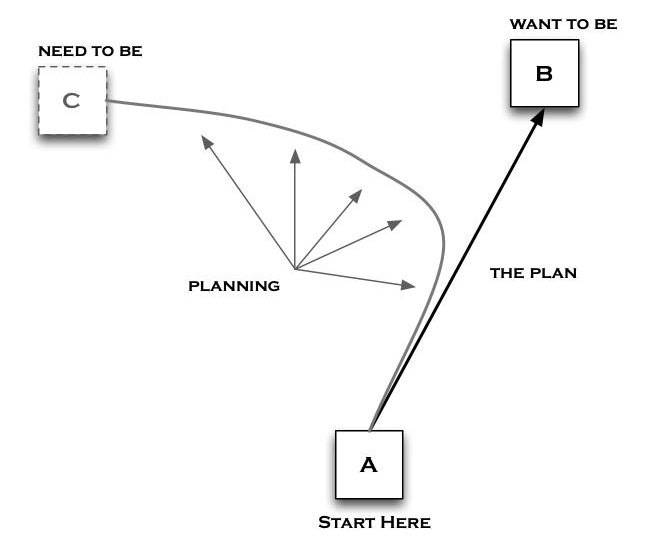 I love the letter P. A powerful plosive that you can’t pronounce without putting your lips together – go on, do it – and then POW!
I love the letter P. A powerful plosive that you can’t pronounce without putting your lips together – go on, do it – and then POW!
We need to mind our P’s on projects, specifically around planning, productivity and progress. All important. Seldom meeting everyone’s expectations. Because they’re hard and gnarly things to get right. Across the board. Think about your current or past projects, how did you get on? So, so? Room for improvement?
There’s always room for improvement. We have to get better at doing them or continue to be average in our project outputs and outcomes. And frankly, who strives to be average these days? Interested? Good. This way.
6 P’s: Prior Planning Prevents Piss Poor Performance
 Planning. Whether you’re planning for content, moving home, christmas lunch, or that family holiday, planning is important.
Planning. Whether you’re planning for content, moving home, christmas lunch, or that family holiday, planning is important.
Take a look at any project, where you start at A and wind up at B. However, you really need to get to C. The plan will get you to B. Good luck with that. But with careful and continuous planning, which challenges assumptions, inspects and adapts as you go, we’ll arrive at C.
The reality is that there are those folks who like to lock and load on a plan. Regardless. Seat belts on, check, and we’re off. They value the plan over planning. These are not bad people. I like plans. But a plan needs to be open to a change of direction based upon empirical evidence and/or trusted information gleaned from the project. So (1), you need to be setup to deal with change, and (2) be proactively looking and listening in all the right places for things that might result in change. That’s planning.
Planning is a mindset. Effective planning requires more discipline from the team to be able articulate clear, quantifiable goals up front. To continually measure progress. To make hard decisions whether to pivot or persevere along on a set path (A to B). It requires teams to continually shine a light on their failures and convince their sponsors to keep faith. That the new or existing path is the path to success. This is why planning often doesn’t happen as much as it should on projects. It’s so much easier and far less hassle to lock and load and just execute on the plan.
The flip side of planning is where teams use it as an excuse not to plan and instead roll with the punches. Not to set clear goals and to just do it. Loose requirements. No vision. No one setting direction. The classic, come on guys, let’s do agile! For the avoidance ANY doubt, this is not agile. The just-do-it plan is bullshit.
4 P’s: Improve Productivity through People, Process, and Products
Productivity. The most successful companies in the world exhibit high levels of productivity. We’ve all seen this in one form or another. Whether you’re eating out, on holiday, getting your car fixed, or where you work; highly productive people and processes look and smell successful. It’s wonderful to witness and even better to be a part of. And right there are the two most important areas for increasing productivity: process and people.
However, the initial focus should be on process innovation. By establishing the process first, we give everything else purpose. The process highlights how and where we, the people, can make a difference. The process helps move product wants (get me a CMS) into real solution needs (find me a digital content platform) by demonstrating how technology can support and improve the business. The process (reduce time to publish video commentary to all supported devices) provides a baseline from which product innovations (create a video authoring tool to capture, tag, share, and store all video content) can be quantified and used to measure the impact on overall productivity. But it starts with well understood, repeatable and predictable processes that have a roadmap for how they can be improved upon over time. And again. And then again.
It sounds easy. And it is in theory. But in practice, processes are a nightmare to define, understand and change once in flight. Like us, a business becomes set in its ways. They’re run by people. Creating, nurturing and executing a culture of change is hard and a common stumbling for process innovation. Thankfully are countless strategies and tactics for doing this. Google is awash with them. But for 2013 we should be mindful that high levels of productivity start by understanding and then improving the processes, which in turn better supports people in the way they use technology to make their jobs low effort.
3 P’s: Effective Reporting on Progress, Problems, and Plans
Progress. At the start of 2010 I was working on the Skype.Com relaunch that marked that start of paid subscriptions for Skype. The senior Skype team was made up of a number of ex-Apple employees who introduced me to the concept of a PPP status report. Instead of the typical reams of useless information in status reports, at Apple, these guys were used to having immediate and frequent access to useful and relevant project facts. PPP reports where the delivery mechanism for this.
PPP reports communicate three essential facts about a project: progress, problems and plans. There are both informal and informative. Rich in stuff, low in fluff. On Skype, we used them to communicate how the CMS build was progressing, highlighting problems that were becoming blockers and mitigating risks with clear action plans. Our PPP reports were then aggregated and delivered up the management chain, all the way up to executive board, with bits being added and removed to tailor the message for the target audience. They were extremely effective for keeping people in the loop (not necessarily aligned) and were read because they were digestible.
PPP reports were emails for us. Mostly plain text, but HTML-based versions were also distributed because folks like colour and emphasis. With the progress, problems and plans as headlines in the email, each section was comprised of a list of bullet point items. Each bullet point having an owner, description and a date. That’s it.
We (Cognifide) still use them internally as an effective tool on projects to primarily communicate progress against a plan. Elegant in their simplicity. Effective in their delivery.
Summary
So those are my P’s for 2013. Planning, Productivity and Progress. How about you?


Hi Cleve, we made a blog post on the PPP methodology that’s the cornerstone of our Weekdone product. Linked to your blog post and quoted it there as well. Hope you don’t mind 🙂
Hi Cleve, we made a post on the PPP methodology that’s the cornerstone of our Weekdone product.
Here it is:
http://blog.weekdone.com/faqs/progress-plans-problems/
Linked to your blog post and quoted it there as well. Hope you don’t mind 🙂
Pingback: One Powerful Technique to Amplify Team Success - TalentCulture
Pingback: One Powerful Technique To Amplify Team Success
Pingback: Guide: How to Write an Excellent Progress Report (sample template) - Weekdone
Pingback: Status Reporting 101: Everything You Need to Know & Sample Template - Weekdone
Pingback: 3 Step Guide to Status Reports - Weekdone
Pingback: Management Tools: PPP - Plans, Progress, Problems - Weekdone
Pingback: Block Days for Getting Things Done - Cleve Gibbon
Pingback: How to Manage Employees Without Managing Them - Weekdone
Pingback: Measure What Matters - Cleve Gibbon
Pingback: Progreso, planes, problemas » Psicologos en línea
Pingback: Separate Work from Home - Cleve Gibbon
Pingback: Plans, Progress, Problems (PPP) Methodology - Weekdone
Pingback: Team of Teams - Cleve Gibbon
Pingback: Slow Productivity - Cleve Gibbon